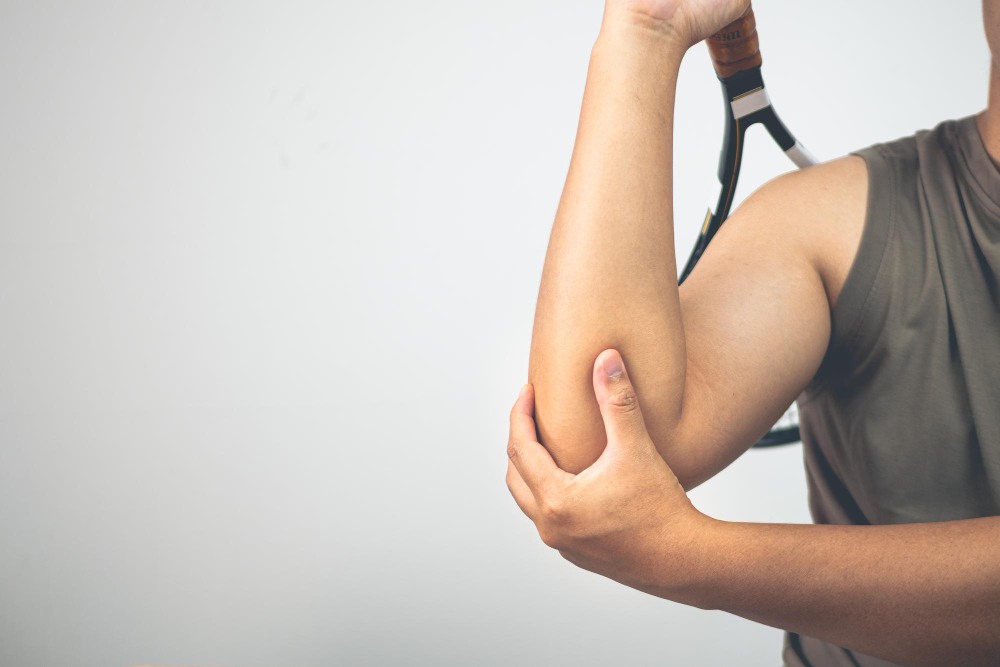What Is Tennis Elbow?

The Condition
The term tennis elbow might lead people to believe that this is a condition that affects only tennis players. However, while it does affect sports players (racquet sports, golfers, bowlers, etc.), anyone who does repetitive activity that involves the arm and wrist could get afflicted with the condition.
For example, painters, cooks, mechanics, etc. are more susceptible to this condition as they are constantly using their arms and wrists. The medical term for tennis elbow is lateral epicondylitis.
- A tendon from the forearm muscle attaches the muscle to the bony part of the elbow.
- When the forearm muscle is overworked, the tendon takes on the load.
- As a result, the tendon also gets overloaded and might suffer damage, resulting in tennis elbow.
- It is a painful condition with pain usually being experienced when trying to hold objects.
The Possible Causes
- As explained above, tennis elbow is usually a result of repeated stress.
- A direct injury to the arm/elbow can also result in this condition.
- It rarely occurs without a cause.
- It is to be noted that the incidence of the condition is more in the age group of 30-50 years.
The Symptoms
The onset of tennis elbow is gradual and the pain progresses without rest or treatment. The symptoms include:
- Inability to grip objects
- Tenderness and inflammation at the elbow
- Flexing the elbow is difficult
- Burning sensation or pain in the bony part of the elbow which worsens at night
- Any kind of bending or twisting movement of the arm is painful (turning a door handle)
Tennis elbow usually manifests in the side that is used more but this depends on the kind of activity and the condition may manifest in both the right and left elbows.
Diagnosis
To diagnose tennis elbow, the orthopedic doctor will perform a complete physical examination. He will check the range of motion and will ask about the activities that bring on pain. After that, he might want some of these tests done:
- An x-ray to rule out other causes like fracture or arthritis
- An MRI or CT to determine the extent of damage to muscles and tendons
- An EMG might be suggested to check for nerve compression
The Treatment Options
- Rest is the first line of treatment. When rested, the tendon heals on its own so it is important to give it sufficient rest.
- Pain medication may be given if the condition is too painful.
- The doctor may suggest wearing a brace to support the injured tendon.
- If playing tennis is the cause of the condition, the doctor may recommend seeing an expert to change technique and overcome the cause.
- If the condition is a result of a person’s profession, the doctor might suggest movements which will take the pressure off the tendon while working.
- A physical therapist can help by teaching stretching and strengthening exercises for the forearm muscles.
- Steroid injections will be given if the pain is too intense. The effect of these injections is temporary. It is to be noted that these injections need to be given at the precise location to be effective.
- Ultrasound Therapy: Here, ultrasound waves (sound waves of a high frequency) are applied to the affected part by means of a probe placed appropriately. The ultrasound waves help to reduce pain and promote healing.
- PRP Therapy: Here, the patient’s own blood is taken and the platelet rich plasma component of the blood is separated from it. This is then injected again into the injured area. This is because the platelet rich plasma has growth factors which help in healing. PRP therapy has been found to be very effective in tennis elbow treatment. The number of injections needed vary depending on the severity of the condition.
Tenotomy:
Tenotomy is of two types: percutaneous needle tenotomy and surgical tenotomy.
- Percutaneous needle tenotomy is a procedure that has come into vogue in the last ten years.
- It relies on the natural healing mechanism of the body to heal the injury.
- The procedure is usually done under a local anesthetic.
- A needle is inserted through the skin to pierce the injured tissue at multiple points.
- Tendons do not receive as much blood (and hence oxygen) as the muscles do.
- When the tendon is pierced, the body reacts by supplying more blood to the area to heal the injury. As a result, the body itself heals the damage.
- The procedure takes not more than 20 minutes and no hospitalization is required.
- Pain after the procedure may last for a few days and then dies down.
- The recovery period after the procedure is short.
- Physiotherapy after the procedure helps with recovery.
- Surgical tenotomy is performed under local or general anesthesia.
- This procedure can even be done arthroscopically through smaller incisions.
- It involves removing the injured tissues of the tendon to provide pain relief.
- Patients feel pain relief almost immediately after the procedure but complete recovery might take some time.
- The usage of a splint to immobilize the elbow after surgery may be suggested.
- The success rate of the procedure is high with considerable functionality being restored but surgery is suggested only if none of the other treatment options offer relief.
Prevention:
- It is best to treat the condition with sufficient rest as soon as it starts. Continuing the activity that resulted in it will only serve to worsen it.
- The racquets used should preferably be light weight and of good quality.
- Doing strength training and resistance training to increase forearm and wrist strength will help.
- Performing proper warm-up and stretches before an activity is recommended.
- Icing the elbow if the day’s activity has been particularly intense is helpful.
